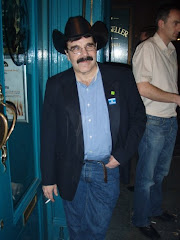Republican Politics, American Style
Published on September 11th in Metro Eireann By Charles Laffiteau
By the time you read this column it will be September 11th, the seventh anniversary of the al Qaeda airliner attacks on the World Trade Center in New York City and the Pentagon in Washington DC. But for Senator John McCain and the Republicans assembled in the Xcel Energy Center here in St. Paul Minnesota last night, it almost seemed like the attacks had come only last week rather than almost seven years ago.
Senator McCain must have used the word “fight” at least three or four dozen times during the course of his Republican Presidential nomination acceptance speech. He then closed his address and got his audience on its feet cheering him by saying “Stand up, stand up, stand up and fight. Nothing is inevitable here. We’re Americans, and we never give up. We never quit. We never hide from history. We make history.” While McCain is correct in his observation that we Americans do make history, unfortunately the type of history we make isn’t always the kind we can (or should) stand up and cheer about.
But the tone of John McCain’s acceptance speech was just one of several remarkably stark contrasts I noted between the Republican and Democratic National conventions over the last two weeks. One of the other more vivid differences was the colour (or maybe I should say lack of colour) of the skin of the participants in the Republican National Convention. While the participants in previous Republican conventions over the past twenty years have also been predominately white and male, I cannot recall one that has ever been either as white or as male dominated as this year’s.
More than two thirds of the 20,000 plus in attendance were men and I would estimate that no more than seven or eight hundred of the Republicans (counting both men and women) were Hispanic, with another three to four hundred members who were black. As a result it wasn’t to difficult to distinguish the racial, gender and ethnic differences between the crowds at the Republican and Democratic conventions. Whereas the Republican convention was probably 95% white Caucasians and 70% male, only two thirds of the convention goers were white and there were equal numbers of men and women at the Democratic convention in Denver.
A worrisome sign for the future of the Republican Party in America is the fact that the Democratic convention in Denver much more nearly reflected the current ethnic, gender and racial makeup of the United States. Why should the Republican Party be concerned? Because based on current demographic trends, thirty years from now Caucasians will represent less than 50% of the United States (US) population, which means the Republican Party has decided to hitch its wagon to the largest but also the most rapidly shrinking segment of the US electorate.
However when I point out my fear, that the Republican Party is on a path which will lead to a semi-permanent status as the minority opposition party in the US, to other Republicans, the vast majority are loathe to acknowledge such a possibility. In fact, more often than not, they usually respond by citing the fact that 44% of Hispanic and Asian voters went for Bush in 2004 while ignoring the reality that these two rapidly growing minority groups still make up only 3% of the total of all Republican delegates.
But as is so often the case, my Republican cohorts won’t be able to acknowledge much less confront the truth about where their party is heading until a series of electoral defeats over the span of several election cycles forces them to. Since the 2006 Congressional elections was actually the first time the Republican Party had lost seats in a generation, I think they will not only have to lose this November but will also have to lose again in 2010 before the party will be ready for some long overdue soul searching.
John McCain’s selection of Sarah Palin as his Vice President was also in sharp contrast with Barack Obama’s pick of Joe Biden as his running mate a week earlier. For several months McCain considered Governors’ Tim Pawlenty and Bobby Jindal, former Governors’ Tom Ridge and Mitt Romney as well as Senator Joe Lieberman to be his Vice Presidential running mate. But when McCain’s campaign aides floated the idea that McCain might pick a pro-choice candidate like Lieberman or Ridge (McCain’s top two choices to be his running mate) as his Vice President, Republican social conservatives put him on notice that they would rebel if he did so.
Because McCain was afraid of arousing the anger of these social conservatives, he resigned himself to finding someone who would please them as his Vice Presidential nominee. While John McCain knew that Pawlenty, Romney and Jindal would all be acceptable choices, none of them were favourites of Republican social conservatives.
So McCain dispatched his campaign aides to interview one of their favourites, Sarah Palin, on Wednesday, met her for the first time on Thursday, and then offered her the job after interviewing her for two hours. At this point I can’t decide which disturbs me more; McCain’s caving in to social conservatives or the haste with which he made his decision to go with Sarah Palin. I think maybe I’ll leave that for a later column.
Senator Obama also spent a couple of months doing background checks in addition to traveling and making campaign appearances with Governors’ Tim Kaine and Kathleen Sebelius as well as Senators’ Jack Reed, Evan Bayh, Chuck Hagel and Joe Biden as part of his evaluation process. But unlike Senator McCain, Obama did not make his choice of Joe Biden in haste or as a reaction to pressure from many Democrats to select Hillary Clinton as his running mate. Obama did so because he thought it was important to purposely select a nominee he both liked and respected and because he knew that picking Clinton as his Vice President would severely undercut his message of “Change”.
Subscribe to:
Post Comments (Atom)



No comments:
Post a Comment